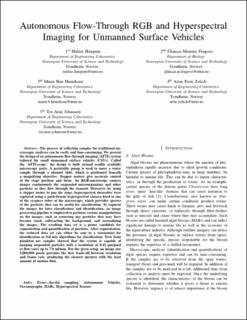| dc.contributor.author | Haugum, Matias | |
| dc.contributor.author | Fragoso, Glaucia | |
| dc.contributor.author | Henriksen, Marie Bøe | |
| dc.contributor.author | Zolich, Artur | |
| dc.contributor.author | Johansen, Tor Arne | |
| dc.date.accessioned | 2024-02-22T12:29:43Z | |
| dc.date.available | 2024-02-22T12:29:43Z | |
| dc.date.created | 2024-01-02T18:55:45Z | |
| dc.date.issued | 2023 | |
| dc.identifier.issn | 0197-7385 | |
| dc.identifier.uri | https://hdl.handle.net/11250/3119359 | |
| dc.description.abstract | The process of collecting samples for traditional microscopic analyses can be costly and time-consuming. We present the design of an autonomous flow-through imaging (AFTI) system tailored for small unmanned surface vehicles (USVs). Called the ’AFTI-scope’, the design is built around readily available microscopy parts. A peristaltic pump is used to move a water sample through a channel slide, which is positioned beneath a magnifying objective. Stepper motors give accurate control of the stage position and focus. An RGB-microscope camera images continuously the suspended microorganisms and other particles as they flow through the channel. Moreover, by using a stepper motor to pan the stage, hyperspectral datacubes were captured using a push-broom hyperspectral camera fixed to one of the eyepiece tubes of the microscope, which provides spectra of the particles that can be useful for classification. To segment the images for later classification and identification, an image processing pipeline is employed to perform various manipulations on the images, such as removing any particles that may have become stuck, subtracting the background, and normalizing the images. The resulting data set is a prime candidate for segmentation and quantification of particles. After segmentation, the reduced data set can either be sent to a taxonomist for identification or fed into algorithms for classification. Tests from plankton net samples showed that the system is capable of imaging suspended particles with a resolution of 0.41 µm/pixel at flow rates up to 7.8 ml/min. For the given setup, an image size 1280x960 pixels provides the best trade-off between resolution and frame rate, producing the clearest pictures with the least amount of motion blur. | en_US |
| dc.language.iso | eng | en_US |
| dc.publisher | IEEE | en_US |
| dc.rights | Navngivelse 4.0 Internasjonal | * |
| dc.rights.uri | http://creativecommons.org/licenses/by/4.0/deed.no | * |
| dc.title | Autonomous Flow-Through RGB and Hyperspectral Imaging for Unmanned Surface Vehicles | en_US |
| dc.title.alternative | Autonomous Flow-Through RGB and Hyperspectral Imaging for Unmanned Surface Vehicles | en_US |
| dc.type | Journal article | en_US |
| dc.description.version | acceptedVersion | en_US |
| dc.rights.holder | © Copyright 2023 IEEE - All rights reserved. | en_US |
| dc.source.journal | OCEANS | en_US |
| dc.identifier.doi | https://doi.org/10.1109/OCEANSLimerick52467.2023.10244605 | |
| dc.identifier.cristin | 2219356 | |
| dc.relation.project | Norges forskningsråd: 325961 | en_US |
| dc.relation.project | Norges forskningsråd: 327670 | en_US |
| dc.relation.project | Norges forskningsråd: 315514 | en_US |
| dc.relation.project | Norges forskningsråd: 223254 | en_US |
| cristin.ispublished | true | |
| cristin.fulltext | postprint | |
| cristin.qualitycode | 0 | |

